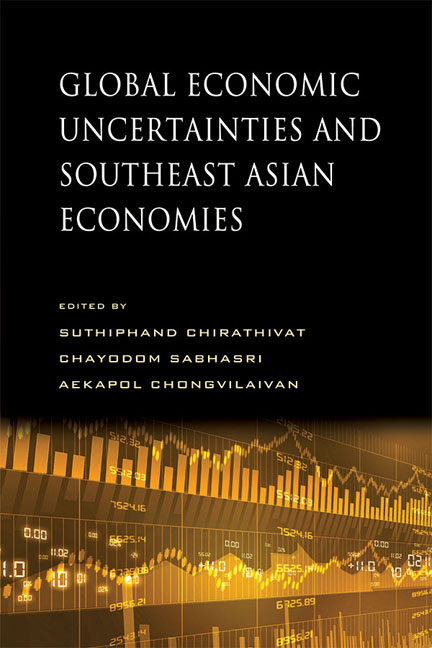Book contents
- Frontmatter
- Contents
- Preface
- Contributors
- 1 Challenges Facing a Globally Connected ASEAN
- 2 Fragile Balance of Payment in Indonesia under Global Economic Uncertainties
- 3 Malaysia in the Midst of Global Economic Uncertainties
- 4 Singapore: Reinventing Itself amid Global Economic Uncertainties
- 5 Thailand: Dependency or Diversification?
- 6 Vietnam's Economic Experience since WTO Accession
- 7 Global Economic Imbalances and Reform Policy: Evidence from Asian Economies
- 8 Foreign Exchange Rate Adjustment Policies in Asia
- 9 Monetary and Financial Architectures for ASEAN+
- 10 Global Uncertainties: Implications for the ASEAN Community
- Index
Preface
Published online by Cambridge University Press: 22 July 2017
- Frontmatter
- Contents
- Preface
- Contributors
- 1 Challenges Facing a Globally Connected ASEAN
- 2 Fragile Balance of Payment in Indonesia under Global Economic Uncertainties
- 3 Malaysia in the Midst of Global Economic Uncertainties
- 4 Singapore: Reinventing Itself amid Global Economic Uncertainties
- 5 Thailand: Dependency or Diversification?
- 6 Vietnam's Economic Experience since WTO Accession
- 7 Global Economic Imbalances and Reform Policy: Evidence from Asian Economies
- 8 Foreign Exchange Rate Adjustment Policies in Asia
- 9 Monetary and Financial Architectures for ASEAN+
- 10 Global Uncertainties: Implications for the ASEAN Community
- Index
Summary
Southeast Asia entered its worst post-1997 recession against the backdrop of the global economic breakdown in 2008–9. Southeast Asian countries were able to decouple themselves from the ripple effects of the global financial shocks and bounced back strongly in 2009–10, thanks to their growing domestic markets, limited financial exposure to the crisis epicentres, and timely stimulus packages. The major Southeast Asian countries like Singapore, Malaysia and Thailand in 2010 exhibited a V-shaped recovery with staggering GDP growth of 15.0, 6.5 and 6.2 per cent, respectively, from a sharp contraction in 2009, while Indonesia, the Philippines and CLMV (Cambodia, Laos, Myanmar, Vietnam) countries demonstrated exceptional resilience. More recently, however, Europe's worsening financial and banking crisis and a sluggish recovery of the United States have dampened Southeast Asia's growth prospects. According to the latest estimates by the Asian Development Bank (ADB), the escalating global economic uncertainties have seen Southeast Asia's growth forecast revised downwards to 6.6 per cent in 2012 and 7.1 per cent in 2013, from the earlier estimates of 6.9 per cent and 7.3 per cent, respectively.
The current global economic circumstances underscore the risks of disproportionate dependence on exports as a crux engine of growth and the unsustainable features of overproduction in developing Asia, upheld by undue consumption in the United States and the European Union. There is a need, therefore, for Southeast Asia to bolster domestic demand and to put greater emphasis on intra-regional sources of economic potentials. For the time being, the region is in dire need of an optimal mix of macroeconomic and trade policy measures that differ by country, underpin domestic demand, and revive the domestic economies. More importantly, a new phase of Southeast Asia's economic policy needs to address several socio-economic issues which constitute a root cause of the imbalances — including a lack of social security, underdeveloped and incomplete intra-regional financial markets, rapidly increasing income inequality, and limited competition among service products, and put in place a shield against emerging challenges such as a shift of demands towards East Asia, managing capital flows, escalating intra-regional trade linkages, and the mounting significance of intra-industry trade and trade in differentiated products.
Nevertheless, the quest for concrete regional actions and coordination has been plagued by the complication of individual economies and the diverse levels of economic and cultural development, on top of the widely varied states of statistical accuracy and, not least, secrecy.
- Type
- Chapter
- Information
- Publisher: ISEAS–Yusof Ishak InstitutePrint publication year: 2015



